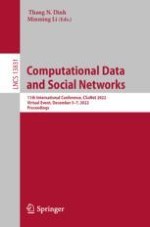2023 | Book
Computational Data and Social Networks
11th International Conference, CSoNet 2022, Virtual Event, December 5–7, 2022, Proceedings
Editors: Thang N. Dinh, Minming Li
Publisher: Springer Nature Switzerland
Book Series : Lecture Notes in Computer Science
